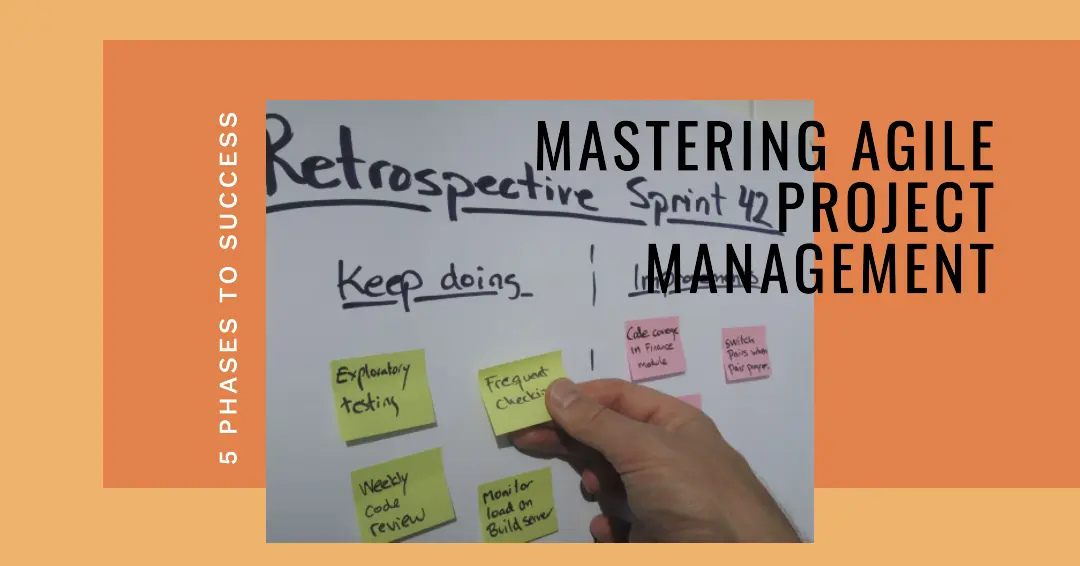To find out how Artificial Intelligence is changing the Project Management landscape, you may enjoy reading this article https://www.shaunstoltz.com/did-artificial-intelligence-just-change-everything-about-project-management/
I. Introduction
Hello, fellow Agile enthusiasts! Are you ready to embark on an exciting journey to master the art of Agile project management? If so, you’re in the right place. Agile has taken the world by storm, and for good reason. It offers a flexible and collaborative approach to project management, empowering teams to deliver high-quality products faster and more efficiently.
In today’s fast-paced world, understanding the five phases of Agile project management is essential. Whether you’re a seasoned professional or just starting in the field, mastering these phases will help you navigate complex projects with ease and deliver exceptional results.
My goal in this blog post is to provide you with practical advice on successfully navigating each of the five Agile phases. I’ll share my experiences, insights, and tried-and-true tips to ensure that you’re well-equipped to tackle any project that comes your way. So, grab a cup of coffee, and let’s dive in!
Stay tuned as we explore the five phases of Agile project management:
- Envision
- Speculate
- Explore
- Adapt
- Close
Together, we’ll learn how to effectively move through each phase, build better products, and create a culture of continuous improvement within our teams. Are you ready to become an Agile master? Let’s get started!
II. Phase 1: Envision
Welcome to the first phase of our Agile adventure: Envision! This phase sets the foundation for your entire project, so it’s crucial to get it right. Here, we’ll define the project vision, assemble the team, and develop the product roadmap. Let’s get started!
A. Define project vision and goals
You know what they say: “If you don’t know where you’re going, any road will take you there.” The same applies to Agile project management. Aligning your project with organizational objectives and setting SMART (Specific, Measurable, Achievable, Relevant, and Time-bound) goals will give your team a clear direction and ensure everyone’s on the same page.
In my experience, involving stakeholders in this stage is invaluable. Their insights can help shape the project vision and create a strong sense of ownership, setting the stage for a successful project.
B. Assemble the team
Ah, the dream team! Building a cross-functional team is vital for Agile success. You’ll want to assemble a diverse group of individuals with a range of skills and expertise. Remember, the key to a high-performing Agile team is collaboration, so don’t forget to consider each person’s ability to work well with others.
Once your team is assembled, clearly outline roles and responsibilities. This helps ensure that everyone knows their part in the project, fostering accountability and teamwork.
C. Develop the product roadmap
With your vision, goals, and team in place, it’s time to create the product roadmap. This is your high-level guide to the project, outlining features, prioritizing requirements, and estimating effort and timelines.
As an Agile pro, I can’t stress enough the importance of flexibility in this stage. Your roadmap is a living document, and changes are inevitable. Embrace them and keep your team informed to ensure a smooth journey ahead.
D. Tips for success in the Envision phase
- Communicate, communicate, communicate! Open dialogue is crucial to aligning your team and setting expectations.
- Encourage collaboration and creative problem-solving. Remember, many heads are better than one!
- Be prepared to adjust your plans as new information emerges. Agility is the name of the game!
Congratulations! You’ve successfully navigated the Envision phase of Agile project management. Now it’s time to move on to the Speculate phase, where we’ll develop user stories and create a release plan. Stay tuned, and let’s continue our journey to Agile mastery!
III. Phase 2: Speculate
We’ve made it to the Speculate phase! Give yourself a pat on the back – you’re doing great. In this phase, we’ll develop user stories and create a release plan. These elements will help guide your team as you work to bring your project vision to life.
A. Develop user stories
User stories are the heart of the Speculate phase. They’re simple, yet powerful tools that describe the features and functionality of your product from the user’s perspective. Writing effective user stories not only helps your team understand what they’re building, but also ensures that the end result meets users’ needs.
To create a user story, follow this formula: “As a [user role], I want to [goal] so that [reason].” This keeps the focus on the user and encourages your team to think about the value each feature provides. Once you have a collection of user stories, prioritize them based on importance, dependencies, and potential risks.
B. Create the release plan
With your user stories in hand, it’s time to create the release plan. This outlines the goals for each release and helps you manage the scope, timeline, and resources required to deliver your product.
Begin by identifying the most critical user stories and grouping them into releases. Establish goals for each release, such as addressing high-priority features or meeting specific deadlines. Keep in mind that Agile is all about flexibility, so be prepared to adapt your plan as new information or requirements emerge.
C. Tips for success in the Speculate phase
- Involve your team in user story development. Their diverse perspectives can help identify potential gaps or areas for improvement.
- Keep your release plan realistic and adaptable. Don’t be afraid to revise it as needed throughout the project.
- Use tools like backlog grooming and sprint planning to continuously refine your user stories and release plan.
You’ve now completed the Speculate phase – well done! Up next is the Explore phase, where we’ll plan and execute iterations (sprints), inspect and adapt our work, and monitor progress. Stay tuned for more Agile wisdom as we continue on this exciting journey together!
IV. Phase 3: Explore
You’re making excellent progress on our Agile adventure! In the Explore phase, we’ll dive into the heart of Agile project management: planning and executing iterations (sprints), inspecting and adapting our work, and monitoring progress. Are you ready to explore? Let’s go!
A. Plan and execute iterations (sprints)
Sprints are the lifeblood of Agile projects. These short, focused periods of work (usually 2-4 weeks) allow your team to develop, test, and deliver increments of your product. To kick off each sprint, you’ll want to set clear goals that align with your release plan and user stories.
Running daily stand-up meetings is essential for keeping everyone on track during a sprint. These brief, time-boxed meetings (no more than 15 minutes!) provide an opportunity for your team to share updates, discuss challenges, and plan their work for the day. Remember, the key to a successful stand-up is keeping it short, sweet, and focused.
B. Inspect and adapt
Agile is all about learning and improving, and the Explore phase is no exception. Regular sprint retrospectives provide a valuable opportunity for your team to reflect on their work, identify areas for improvement, and develop actionable plans for change.
Don’t shy away from discussing challenges or failures during retrospectives. These conversations can be incredibly powerful catalysts for growth and improvement. Just remember to approach them with a positive, solution-oriented mindset.
C. Monitor progress
Tracking your team’s progress during sprints is crucial for maintaining momentum and identifying potential roadblocks. Tools like burndown charts can help visualize sprint performance and highlight areas where adjustments may be needed.
Regularly reviewing team velocity (the amount of work completed during a sprint) can also help you make informed decisions about future sprint planning and resource allocation. Keep in mind, though, that velocity is just one metric; it’s important to consider other factors like quality, user satisfaction, and team morale.
D. Tips for success in the Explore phase
- Set clear sprint goals and ensure that all team members understand their role in achieving them.
- Foster a culture of continuous improvement through open and honest retrospectives.
- Use metrics like burndown charts and velocity to inform decision-making, but don’t let them dictate your every move.
Great job! You’ve successfully navigated the Explore phase. Now, it’s time to move on to the Adapt phase, where we’ll review and refine the product, and reassess priorities and goals. Keep up the fantastic work as we continue to master the art of Agile project management!
V. Phase 4: Adapt
You’re doing an amazing job on our Agile journey! As we enter the Adapt phase, we’ll focus on reviewing and refining our product, and reassessing our priorities and goals. This phase is all about embracing change, learning from our experiences, and making informed decisions. Let’s dive in!
A. Review and refine the product
In the world of Agile, feedback is gold. Gathering user feedback and incorporating it into your product is essential for ensuring it meets users’ needs and expectations. It’s important to continuously review and refine your product based on this feedback, as well as any new requirements that may emerge.
Remember, Agile is all about embracing change and adapting to new information. Don’t be afraid to pivot or make significant updates to your product if it ultimately leads to a better outcome.
B. Reassess priorities and goals
As you progress through your project, it’s crucial to regularly evaluate your progress and reassess your priorities and goals. This may involve reprioritizing user stories, adjusting release plans, or even redefining the project vision.
Taking the time to reassess ensures that your project remains aligned with your organization’s objectives and that your team is focusing on the most valuable work. In the ever-evolving world of Agile, staying adaptable and responsive is key to success.
C. Tips for success in the Adapt phase
- Establish a feedback loop with your users to continuously gather insights and improve your product.
- Be open to change and embrace new information that could lead to better outcomes for your project.
- Foster a culture of learning and growth by celebrating successes and learning from challenges.
Well done! You’ve successfully navigated the Adapt phase. Now, it’s time for the final phase of our Agile adventure: the Close phase. In this phase, we’ll finalize our product, document lessons learned, and celebrate our team’s achievements. Let’s bring this journey to a triumphant close!
VI. Phase 5: Close
Congratulations on reaching the final phase of our Agile journey: the Close phase! You’ve come a long way, and now it’s time to finalize your product, document lessons learned, and celebrate your team’s achievements. Let’s finish strong!
A. Finalize the product
As your project comes to an end, it’s essential to conduct thorough testing and quality assurance to ensure your product is ready for launch. This is the time to polish any rough edges, fix lingering issues, and make sure your product meets users’ expectations.
Preparing for a product launch involves more than just technical considerations. It also requires coordination with marketing, sales, and support teams to ensure a smooth and successful rollout.
B. Document lessons learned
One of the most valuable aspects of Agile project management is the opportunity to learn and grow from each project. As your project wraps up, take the time to document your successes, challenges, and areas for improvement. Reflect on your team’s experiences, and consider how you can apply these insights to future projects.
Sharing your lessons learned with your organization can also help spread Agile best practices and contribute to a culture of continuous improvement.
C. Celebrate and recognize team achievements
Last, but certainly not least, it’s time to celebrate! Acknowledging your team’s hard work, dedication, and achievements is crucial for maintaining morale and fostering a sense of camaraderie. Take the time to recognize individual contributions, celebrate your successes, and express gratitude for the efforts of your team members.
D. Tips for success in the Close phase
- Allocate sufficient time and resources for final testing and quality assurance.
- Encourage your team to reflect on their experiences and share lessons learned with the organization.
- Recognize and celebrate your team’s achievements, both as a group and individually.
VII. Conclusion
And just like that, our Agile adventure comes to an end. We’ve explored the five phases of Agile project management, learned valuable tips and strategies for success, and embraced the importance of adapting and evolving throughout the project lifecycle.
As you continue to hone your Agile project management skills, remember to stay curious, open-minded, and always be ready to learn from your experiences. Here’s to your future success as an Agile master!
Until our next adventure, happy project managing!
Find out more about Shaun Stoltz https://www.shaunstoltz.com/about/
This post was written by an AI and reviewed/edited by a human.



